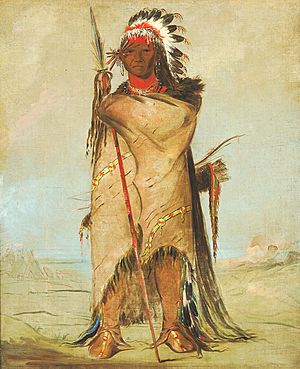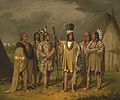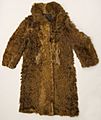Buffalo robe facts for kids
A buffalo robe is a special kind of blanket or covering. It's made from the hide (skin) of an American bison, often called a buffalo. The hair is left on, making it warm and soft. Native American people living in the vast grasslands of North America used these robes. They were important for warmth, as saddles, and for trading with others.

Some robes were painted with special pictures called pictographs. These pictures often told stories or showed important events. They could be like a calendar, recording things like big battles or times when food was scarce. These special robes were sometimes called winter counts.
Why Were Buffalo Robes So Important?
For many years, buffalo robes were very valuable. From the 1840s to the 1870s, people in big cities like New York and Montreal wanted lots of them. They used the robes as warm blankets in carriages and sleighs. They also made them into thick, warm coats.
This high demand for robes caused a big problem. It led to the near extinction of the American bison. Millions of bison were hunted, mainly for their hides.
When Were Robes Made?
Only bison hides taken in winter were good for making robes. This was usually between November and March. During these months, the bison's fur was thickest and best.
Hides taken in the summer were not as valuable for robes. Their fur was too thin. Summer hides were often used for other things, like covering tipis (Native American homes) or making moccasins (soft shoes).
Gallery
-
Chief Big Elk painted from life by George Catlin in 1832.
-
Karl Bodmer's portrait of an Arikara warrior wearing a beaded buffalo robe, early 1840s.
-
Six Blackfeet Chiefs - Paul Kane 1859.
-
Knife River Villages buffalo robe with a "Feathered Sun" design.
See also
- Métis buffalo hunt#Buffalo robe trade
- Plains hide painting
- Koryaks#Culture









